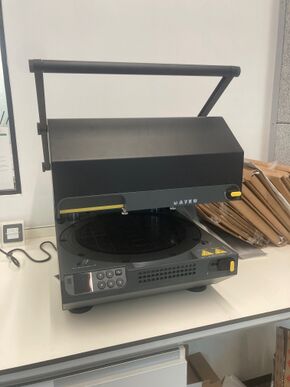Mayku Multiplier: Difference between revisions
Makerspace (talk | contribs) No edit summary |
|||
| Line 47: | Line 47: | ||
* [[Media:Mayku-Multiplier-Machinery-Manual.pdf|PDF - Mayku Multiplier Instruction Manual]] | * [[Media:Mayku-Multiplier-Machinery-Manual.pdf|PDF - Mayku Multiplier Instruction Manual]] | ||
* [https://mayku.me/learn/creating-thermoforming-templates-with-fdm-3d-printing Creating Thermoforming Templates with FDM 3D Printing - Mayku] | |||
* [https://mayku.me/faq/what-materials-are-available-for-the-mayku-multiplier What materials are available for the Mayku Multiplier? - Mayku] | * [https://mayku.me/faq/what-materials-are-available-for-the-mayku-multiplier What materials are available for the Mayku Multiplier? - Mayku] | ||
* [https://mayku.me/learn/template-design-creation Template design and creation - Mayku] | * [https://mayku.me/learn/template-design-creation Template design and creation - Mayku] | ||
Latest revision as of 10:49, 3 June 2024
| This placeholder article needs more information adding to it. More details are coming soon, if you can please ask the technical staff for a wiki account and help out. |
 | |
| Vacuum/Pressure former. | |
| Equipment Information | |
|---|---|
| Status | Unknown |
| Manufacturer | Mayku |
| Model | Multiplier |
| Working Area | 380mm diameter |
| Maker Space Information | |
| Training Required | Yes |
| Training Information | Here |
The Mayku Multiplier is a pressure former - it works in a manner similar to a typical vacuum former, but it also uses compressed air to force the material around the mould. This means you can achieve very high fidelity.
Training
Please ask a member of technical staff to be shown how to use this equipment.
Read through the instruction manual before using the machine to get the most out of the training.
Material
The Multiplier can form a variety of materials - there is a selection available in the boxes next to the machine. Materials range from PETG and ABS to HIPS and EVA foam.
It is possible to use custom materials in the machine but it requires a bit of experimentation to determine the optimum settings.
Reducing Plate
Currently the material used is a whole 400 mm diameter circle which can be a wasteful if you are using expensive material or only forming a small mould.
We have a reducing plate on order. This will allow you to use A4 sized material on the Mayku which should reduce costs and environmental impact quite dramatically.
Mould/former design
The Mayku website has a lot of information about designing template moulds and formers - take a look through their information before designing a part.
Draft Angle
You must consider draft angle when designing your parts - this is a taper that allows easy release of parts from moulds and formers. It is required when designing vacuum form moulds as well as injection moulds - anything where the mould or form is rigid and cannot be flexed or stretched to extract parts (like would be the case with a silicone mould).
To a certain extent it is also a concern when designing parts for CNC machining - deep wall sections can require long and expensive tools to machine.
- 5 Ways to Improve Part Mouldability with Draft
- Why is draft angle design essential for injection molding?
Undercuts
Undercuts will not necessarily be formed correctly, and may lock your mould into the final part. Avoid these wherever possible.
Corner Fillets
Rounding sharp corners can make your design more reliable to form. Sharp corners can poke through and pierce the final part, especially if the material is especially thin or the material is being stretched a long way.
Maximum mould height
The inside of the forming area is a dome - this is for maximum strength when pressurising the system. It's important to not have a former which is too high near the perimeter of the material as it may collide with the sides of the pressure vessel. The maximum height in the centre of the forming area is 160mm. There are progressive reductions in this maximum height marked on the forming area.
